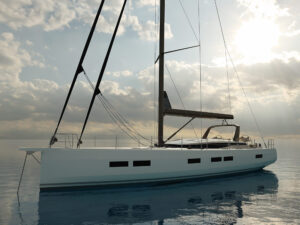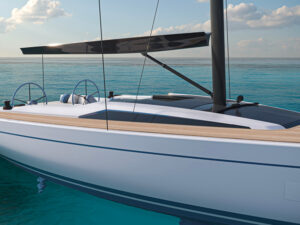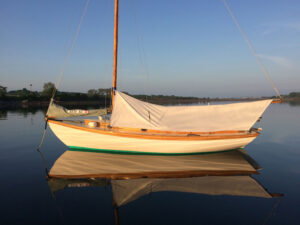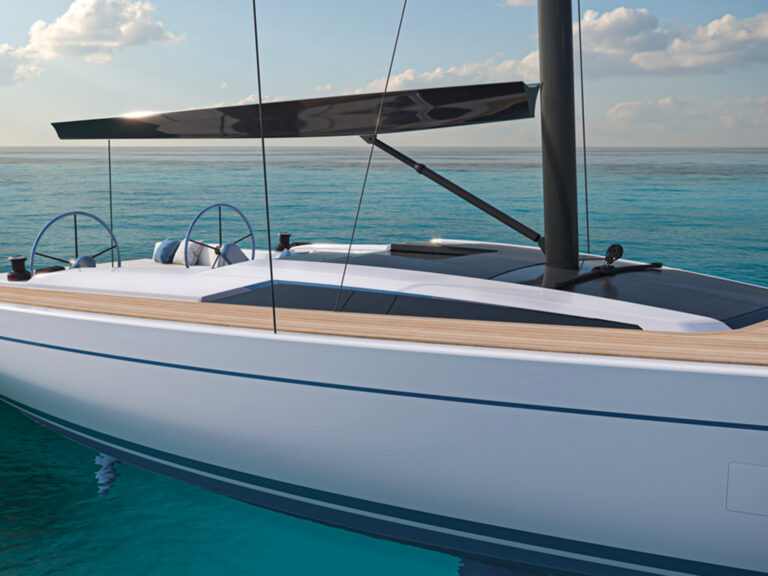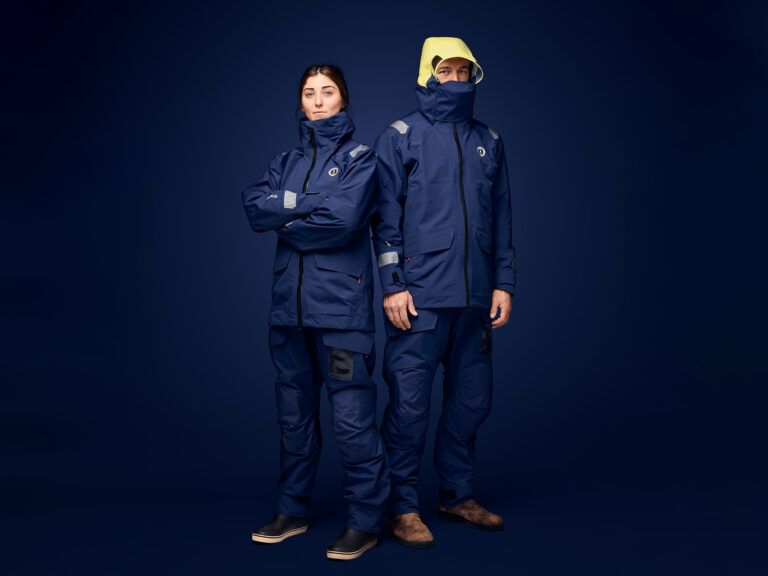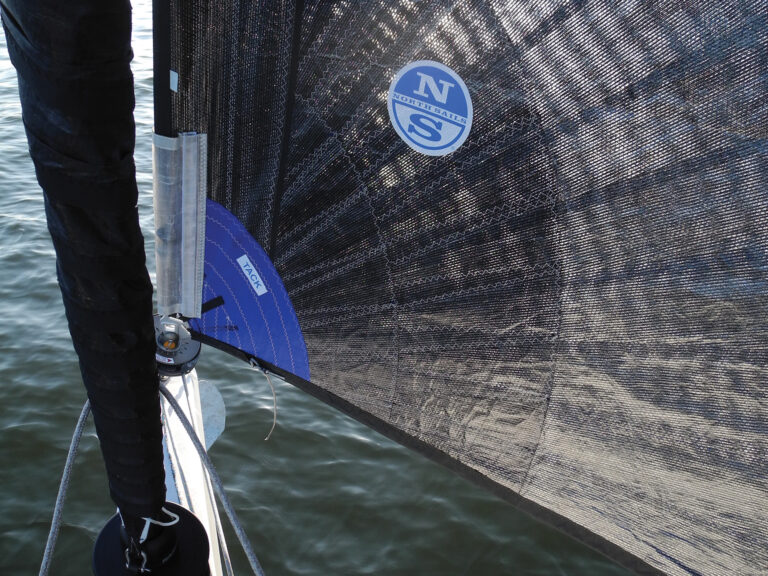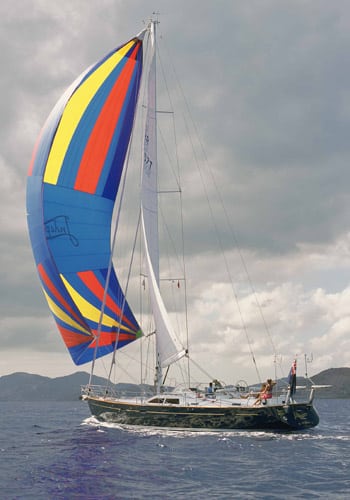
Moody 64
In southern Florida, the locals have a quip for those times when a 25-knot norther stacks the waves in the Gulf Stream so that the horizon appears like a long stretch of undulating hills: “The elephants are walking.” On those days, it’s usually best to stay inshore to avoid being trampled. But the Moody 64, a powerful Bill Dixon-designed cutter, doesn’t shy away from bleak forecasts, as I learned last February. The elephants were walking, but with 66,000 pounds of displacement to cushion the ride, a few soggy pachyderms weren’t going to spoil our day.
The Moody 64 is what Dixon calls “a crossover boat,” one that, through the efficient use of power-furling gear and winches, is designed to be managed by two very capable sailors but is big enough to attract those who expect to have family, friends, or crew aboard for more than just a few days. With a high-aspect masthead cutter rig, a fine bow, minimal wetted surface, and 22,000 pounds of ballast concentrated in a bulb at the bottom of its standard 8-foot-6-inch fin keel, the Moody 64 doesn’t conceal her aspirations for fast passages. In the 2002 Atlantic Rally for Cruisers (ARC), hull number one smoked a fleet full of long-legged Oysters and Swans to win Class A and take fourth overall. She covered the 2,680-mile transatlantic course from Gran Canaria to St. Lucia in just under 13 1/2 days–that’s 200 miles per day.
While the 88-foot mast and deep draft limit your options on, say, the Intracoastal Waterway, the Moody’s best attributes would be wasted on The Ditch anyway. On a day that called for 12-foot seas in the Gulf Stream, we steamed out Miami’s Government Cut at a comfortable 8.6 knots with the 230-horsepower turbocharged Yanmar running at 2,000 rpm, just over half throttle, which is probably all she’ll ever need. Below, the well-insulated walk-in engine room reduced the rumble to a low hum.
The Moody’s hull is hand-laid fiberglass cored with inch-thick end-grain balsa bedded in a polyester bonding paste. Solid laminate is used wherever there are through-hull penetrations and also at the stem, keel, and skeg. A complex mix of glassed-in floors and stringers in the keel and main bilge area and in structural bulkheads and chainplate supports help stiffen the hull. Bonded-in tray moldings also provide support in the forward and after sections. The deck is both bonded and mechanically fastened to an inward-turning flange on the hull. Monel rivets driven through an aluminum backing plate in the flange serve as the mechanical fasteners. The deck-edge bulwark is then fitted with a laminated teak caprail. A full-length rubrail protects the hull, which comes in three gelcoat colors: blue, white, and burgundy. Meticulous computer-assisted design (CAD) engineering and a long background in streamlined production give the builder, Princess Yachts, the ability to produce eight to 10 of these boats each year.
Under Way
The Moody has a partially exposed skeg-hung rudder and a propeller offset slightly to starboard (so the shaft will clear the skeg when it’s removed for service or inspection). It maneuvers quite handily in tight quarters thanks to the standard 15-horsepower Sleipner bow thruster. The Whitlock steering system, with a 1/2-horsepower Whitlock Mamba autopilot drive, uses robust direct rod linkages to transfer torque to the rudder shaft and provide smooth and positive control from the helm.
Once we cleared the sea buoy, we began tacking north, carrying what would be an excellent heavy-weather sail plan: full staysail and main reefed to the second spreader. The wind was gusting above 25 knots, and though we could clearly carry more canvas, we footed to windward at a dry, relaxing, and extremely comfortable 6.5 knots. Waves inside the drop-off were running about 5 feet, and the periods were short, but the Moody’s fine bow sliced through the slop without laboring. Below, in the cavernous main saloon, the motion was slow and easy, although the area around the mast exhibited a few squeaks of protest.
When we raised the mainsail to just under the top spreader and unrolled the yankee, the Moody sprang to life. On a beam reach, with the wind gusting over 20 knots, we surged ahead at just under 10 knots, and we could have held that speed all day. Hard on the wind, the boat was very well behaved, and we were able to bring the apparent wind to less than 35 degrees true before feeling pinched.
Deck Details
The Moody carries most of its 17-foot beam from the midship station all the way to the aft sections. The beam allows plenty of room for twin 42-inch wheels, each helm with its own bench seat and padded hip rest. The arrangement not only gives you your pick of leeward or windward steering but also opens a clear passage to the bathing platform aft. Working the autopilot controls and instruments on the binnacle requires reaching through the wheel spokes, which could be a problem should you urgently need to disengage the autopilot.
The cockpit is divided by a small step between the higher steering stations aft and the lower, ample, main-cockpit area that’s tucked behind a fixed windscreen. The forward area seats six comfortably around a permanent drop-leaf table that has well-placed stainless-steel grabrails. Though this spot offers better protection from the wind and sea, the upper steering station provides a better view ahead and easier access to the main deck. From either perch, you have sufficient command of the sails.
The rig geometry uses triple aft-swept spreaders with cap shrouds, upper and lower intermediates, and aft lower shrouds. The cap and lowers lead to a single deck fitting inboard near the raised cabin top, allowing easy fore-and-aft passage on either side. The load is transmitted from this fitting to a rugged, encapsulated plywood web; the web, in turn, is tied to the gridlike floor structure and main bulkheads.
The foredeck is clear and uncluttered. Stainless-steel line guards protect all cowls, providing convenient handholds as you work your way forward. A huge, 36-inch-diagonal hatch just aft of the inner forestay leads down to the skipper’s cabin and allows for quick launching and stowing of spinnakers or storm sails. The Lewmar 3000 vertical anchor winch serves twin stainless-steel rollers and feeds into a large, self-draining, divided chain locker. Additional storage lies behind the cockpit in a wide and deep lazarette that’s essentially a seagoing garage. Also aft is a dedicated locker for an eight-man canister life raft. Stainless-steel dinghy davits are standard.
Belowdecks
Down below, interior designer Roel De Groot uses a combination of chrome, polished stainless steel, curved wood panels, and fabrics to project elegance as well as meet the fundamental requirements of an oceangoing boat. Though you can’t alter the standard layout at the factory, personalization comes through the selection of upholstery and curtain fabrics and the choice of satin-finished teak or cherry veneer for furnishings. The cabin sole is simulated teak-and-holly veneer. Although stairs at five different locations disrupt an otherwise flowing floor plan, they fall at natural transition points between cabins or stations and have LED courtesy lighting. After a while, these ups and downs will become second nature to those who spend time on the boat.
A big C-shaped dinette to port is the centerpiece of the saloon, with a small sofa opposite. Hatches, opening ports, and large saloon windows provide plenty of natural light. Although a grabrail near the companionway is handy for the transition between abovedecks and below, there’s a gap at midsaloon where you wish you had a couple of more handholds.
I was most impressed by the large U-shaped galley that’s one step down from the saloon. Not only does it feature the ideal ergonomic triangular layout of the stove, sink, and fridge; it also has the counter space many homes lack. The fore-and-aft U shape allows hands-free support while under way, and the step down keeps the cook at eye level with those seated in the saloon. My only complaint with the galley was that the push-button drawer and cabinet catches used here and throughout the boat will open when you bump against them, spilling the locker contents–typically at a time when you have more important things to worry about.
The forward-facing nav station is an ample nook with plenty of storage. The passage aft to the owner’s cabin follows behind the nav station. The Moody’s generous beam pays off here, allowing the passage to double as a study, with its own desk and chair, or as a cabin with a temporary sea berth, which folds down when needed. Opposite the study, an engine-room door gives access to most of the ship’s systems.
Stretching the full width of the boat aft, the owner’s cabin features a queen-size centerline berth flanked by settees. A secondary benefit of the twin-wheel arrangement is the high headroom it allows on either side of the berth and above.
The creature comforts on the boat I sailed included air-conditioning, a compact washer and dryer, two big-screen flat-panel televisions, an icemaker, a wine locker, and a killer custom sound system. From a buyer’s perspective, one of the most attractive features of the Moody 64 is the long list of standard equipment. This includes a Raymarine instrument package, a Lewmar power windlass with remote control from the helm, and Furuno radar and chart plotters at the helm and nav station.
Bill Dixon and the folks at Moody have come up with a great combination of performance and comfort that’s sure to please anyone who appreciates a smooth turn of speed to go with that chilled California chardonnay. And should foul weather finally catch you, she sure can tame those elephants.
———————————————————————————————————–
Darrell Nicholson is Cruising World’s senior editor.
———————————————————————————————————–
Moody 64 Specs:
LOA 63′ 5″ (19.35 m.)
LWL 54′ 3″ (16.55 m.)
Beam 17′ 6″ (5.33 m.)
Draft 8′ 6″/6′ 6″ (2.59 m./1.98 m.)
Sail Area (100%) 1,794 sq. ft. (167 sq. m.)
Ballast 22,000 lb. (9,979 kg.)
Displacement (half load) 66,220 lb. (30,037 kg.)
Ballast/Disp. .33
Disp./L 185
SA/Disp. 17.05
Water 360 gal. (1,365 l.)
Fuel 528 gal. (2,000 l.)
Mast Height 87′ 11″ (26.80 m.)
Designer Bill Dixon/Roel De Groot
Price $1,490,900
contact:
Moody America
(617) 536-7300
www.moody-yachts.com

